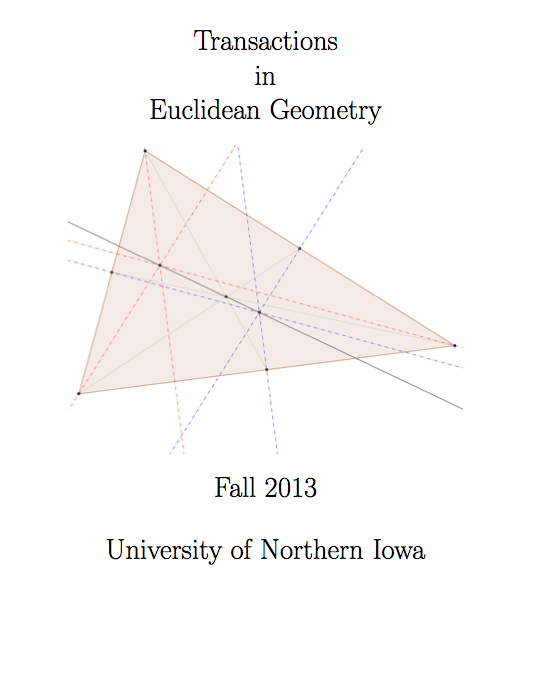Transactions in Euclidean Geometry

As part of the work of this course, we will make a mathematical journal with the students in the course as the authors, referees, and readers. I will play the role of managing editor.
You may find it helpful to have an example of what a finished paper will look like. This is an interesting paper by W. W. Rouse Ball that you should read through.
Issues from the Current Volume (Spring 17)
- Coming Soon!
Instructions for Authors
Those researchers who have successfully presented a result and defended it to the class should then write a mathematical paper to share their results in a definitive form.
Like all professional journals TEG has a specific style that authors must adhere to when submitting. This gives TEG a visual identity. To assist authors, TEG has arranged with a service called Overleaf to submitters with a simple online template for writing papers. Authors can find a fresh copy by clicking the link below:
THE OVERLEAF.COM TEMPLATE FOR WRITING PAPERS
To submit a paper, send an email to the address transactions.editor.uni@gmail.com with the subject line in the form Euclidean Geometry Task ## where you replace the ##’s with the proper identifier for the task. From Overleaf there is an option to download a pdf copy of your paper. Please rename it in the form LastName-Task-##.pdf and attach it to your message.
General Information about the Journal Submission and Review Process
Professional Journals all use some version of a peer review process. TEG does the same. In general, here is how the process works.
- Author writes a paper in a way to conform with the Journal’s declared style.
- Author submits the paper to the editorial board.
- Editorial board finds a referee (or perhaps two, or three). Usually, the author’s name is removed.
- Referee reads paper and checks it.
- Referee writes a report to the editorial board, and takes a stand on whether the paper should be published.
- Editorial board considers opinions of the referee, makes a decision, and forwards the report to the author.
If the referee suggests publication:
Usually, the author has revisions to make to improve the paper. They make these and resubmit. Now the process starts again, but this time goes faster. When all are satisfied, the paper is published.
If the referee does not suggest publication:
The author revises the paper anyway, and looks for a new journal.
We have only one class journal, so getting rejected from the journal will not happen. Extensive rewriting happens pretty frequently, especially at the beginning of the semester.
At the beginning of the semester, I shall act as the managing editor and sole referee. After a few successful papers, you may be asked to referee also.
After submitting a paper, you should expect to get a referee’s report and have some editing to do before the paper gets published. When you have more practice, the amount of reworking a paper requires will likely go down significantly.
Technical Manual for Authors
Papers written for Transactions in Euclidean Geometry should be submitted as Overleaf.com links. Use the template provided above, as this will include all of the relevant styling and structure.
How to Start a Document:
Navigate a web browser to the “Writing” page of our course web site. Follow the link “THE OVERLEAF.COM TEMPLATE FOR WRITING PAPERS.”
When the document comes up, note the url of the web page you are at. This url has a random string at the end which serves as Overleaf.com’s identifier for the file. If you wish to find your file again, you will need this url.
Alternatively, you can make an account at Overleaf.com. This will allow you to keep all of your papers together in a particular place.
How to Use the Overleaf.com template:
Scan down the left-hand pane of the Overleaf setup until you see things that need actual customization. Change the title of the document, and put your name in the author command. Change the rest of the document as appropriate to use your theorems and your arguments supporting them.
How to Include a Figure:
To include a figure, you will first have to make one. I suggest using GeoGebra.
It has a nice “export” feature that will allow you to save a .jpg or a .png
file. Download that file to the desktop of your working machine.
Then upload the figure into Overleaf.com by using the menu item
file-> upload figures, etc. Change the code for a figure in the template to
use the appropriate file name.
How to Submit your Article to the Journal.
To submit a paper, send an email to the managing editor with the subject line
in the form Euclidean Geometry Task ## where you replace the ##’s with the
proper identifier for the task. From Overleaf there is an option to download a
pdf copy of your paper. Please rename it in the form LastName-Task-##.pdf and
attach it to your message. It might be helpful to include the url of the
Overleaf page for your document, too. Send yourself a copy of this email.
This is the way to make sure you can find the file again when you want to edit
it. Documents on Overleaf.com are found by using the proper url, which
contains a fairly random string as an identifier. If you don’t save that string,
it will be near impossible to find your work again.
Managing Editor’s Email address for papers: transactions.editor.uni@gmail.com
Further LaTeX help
Authors may find the LaTeX reference here helpful: A Guide to Using LaTeX
Style Guide for Authors
To help potential authors produce the best work they can, TEG has some style requirements for articles. Please adhere to these when writing.
-
Articles should adhere to standard English usage, grammar, and spelling.
-
Mathematics is written in present tense. It is eternal and enduring.
-
Mathematics is not a personal narrative. Do not choose the personal pronoun “I” when writing. If a personal pronoun must be used, please use “We.”
-
Mathematics is written in an active voice, not a passive voice. If you are unclear on this concept, consider if your sentence might still make sense if you add “by zombies” at the end of it. If so, it is likely a passive voice construction.
For example: The brains were eaten by zombies. All men are created equal by zombies. I got kicked in the face by zombies.
- Each statement written should have a clear justification given from the literature.
References to Euclid’s Elements are given this way: “… by Euclid II.13…” That is a reference to Proposition 13 of Book II of the Elements. References to work produced for this journal should be given by the name of the author and the official sequence number/letter. For example: “… by Mr Jones’ Theorem 2.3…” and “… by Miss Marple’s Theorem F…” are correct.
- Authors are encouraged to include figures which enhance the exposition. A simple visual aid can go a long way toward making an argument understandable. But authors are cautioned that a figure is not an argument, just a supplement. Write as if there is no figure, but include one anyway.
Transactions in Euclidean Geometry strives for a classical feel, so authors are discouraged from using mathematical symbols when words will do. English prose is easier to read than long strings of strange glyphs.
For example: The sentence “Triangle ABC is congruent to triangle XYZ.” is preferable to the sentence “\(\triangle ABC \cong \triangle XYZ \).”
- Authors are strongly discouraged from using mathematical symbols to start sentences. This makes a paper jarring to read, and can lead to confusion.
Information for Referees
Important: Referees should save a copy of the original submission of a paper they review. It will be necessary to include this in your portfolio assignment.
A note about the proper tone:
The peer review process is important for improving the quality of written mathematical work, but receiving a referee’s report is uncomfortable. The process is inherently critical and likely negative.
To reduce the strain on authors, it is critical that a referee depersonalize the comments made. In particular, comments should focus on the paper, and not on the author. The best mode is to focus each comment on some specific aspect of the paper, and to never mention the fact that the paper has an author.
For example: “… paragraph three is confusing. How does one conclude that…” is fine. But “… Mr Jones is stupidly confusing the statement of theorem 4 in paragraph three…” is very bad.
In short, be specific, and talk about features of the paper. If you must reference the author in some way, refer to him or her as “the author,” never by name.
What goes in a report:
Appropriate things to put in a referee report include:
- comments about the logic of an argument
- comments about passages that you feel are confusing
- comments about poor grammar and spelling
- comments about the appropriateness of figures
- comments about the lack of adherence to the style guide of the journal
A challenging thing is that you should limit yourself to pointing out deficiencies, and refrain from making corrections for the author. A suggestion might be allowable. But telling the author how to write a paper is not usually well received.
How to file a report:
Make a simple text document, and type out each comment on its own line. It helps if you start each comment with a bit of location information. For example,
In the third paragraph, the second sentence: the grammar here is unclear.
or
On page 2, third line from the bottom: Is that really ‘triangle DEF’? I expected ‘triangle EDF’.
This report should be shared with the author as soon as is reasonably possible, and within a week in any case.
Department of Mathematics 0506
University of Nothern Iowa
Cedar Falls, IA 50613-0506
Other Contact Information
Office: 327 Wright Hall
Phone: 319-273-2646
email: theron.hitchman@uni.edu
